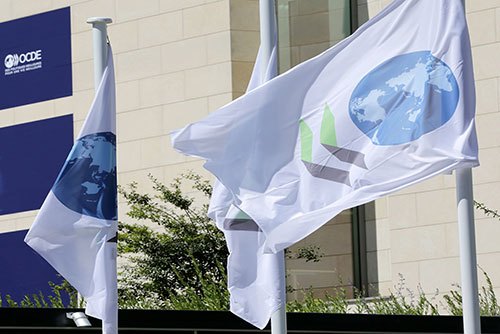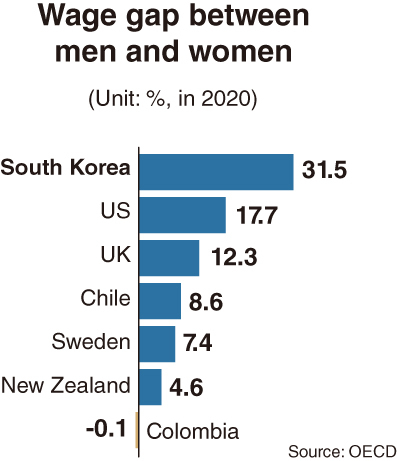[News Focus] Korea to top OECD gender pay gap, again
By Kim Yon-sePublished : Nov. 16, 2021 - 17:51

SEJONG -- South Korea looks set to keep its undesirable No. 1 position in the pay gap between male and female employees in 2020 among the 38 members of the Organization for Economic Cooperation and Development.
According to the organization, Korea posted 31.5 percent in the gender wage gap last year. This means that women earned 31.5 percent less than men on average, a gap that is likely to surpass those of other members, based on previous years’ data.
According to the OECD’s definition, the gender pay gap is the difference between median earnings of men and women relative to the median earnings of men. Of the 38 members, the OECD analyzed the data on the 14 countries that have publicized the latest 2020 figures.

As a noteworthy case, Colombia posted minus 0.1 percent in the gender wage gap last year, which indicates that female workers earned more than their male counterparts.
The figure for Korea contrasted strongly with 9.9 percent in Australia, 9.6 percent in Mexico, 8.6 percent in Chile, 7.4 percent in Sweden, 4.8 percent in Norway and 4.6 percent in New Zealand.
Korea also outpaced the Slovak Republic at 11 percent, the UK at 12.3 percent, the Czech Republic at 12.4 percent, Canada at 16.1 percent, the US at 17.7 percent and Japan (the No. 2 for decades) at 22.5 percent.
Luxembourg, on the basis of its latest 2018 figure, the gender wage gap stood at minus 3.1 percent. The 2019 figure for Costa Rica was 0.0 percent, which means the pay for men and women were the same.
Only four, including Korea, of the 38 members have been posting more than 20 percent in recent years, and Korea is the only member with a figure exceeding 30 percent.
As of 2019, the OECD average and the average of the 27-member European Union stayed at 12.5 percent and 11.2 percent, respectively. Korea has secured the top position since the organization started compiling the relevant data in 1995.
Among the economies with figures under the OECD average were France (11.8 percent in 2018), Turkey (10 percent in 2018), Spain (8.6 percent in 2018), Italy (5.7 percent in 2018), Denmark (5.1 percent in 2019) and Belgium (3.4 percent in 2018).
“The wide disparity in 1995 -- 44.2 percent in Korea vs. 18.9 percent in OECD -- has somewhat narrowed over the past two decades. But the level in the nation is still critical compared to global standards,” a labor market researcher in Seoul said.
A research fellow from the Korea Employment Information Service was quoted by a media outlet as saying that “there is a high possibility that many women -- after marriage and giving birth -- reenter the job market in an underemployment status (for example, as nonregular employees) due to suspension of their career for years. Further, the reentering itself is difficult in Korea.”
The argument suggests that the gender salary gap is wider among those in their 40s and 50s, compared to those in their 20s and 30s.
Some online commenters argue that the sexual discrimination in payment still exists in many local businesses.
They highlight the data held by Statistics Korea, in which the portion of nonregular workers, which came to 47.4 percent -- an all-time high -- of all female workers as of 2020, while the figure for men stood at 31 percent.
But some others push back against these arguments. They say that a dominant portion of the employed in physically risky and demanding sectors, such as construction and heavy industry, are men. They also claim that men usually take on more physically demanding and overnight duties than women in ordinary workplaces.
By Kim Yon-se (kys@heraldcorp.com)


















![[Today’s K-pop] Treasure to publish magazine for debut anniversary](http://res.heraldm.com/phpwas/restmb_idxmake.php?idx=642&simg=/content/image/2024/07/26/20240726050551_0.jpg&u=)